#bec du hoc
Explore tagged Tumblr posts
Text
Paysages - peintures à l'huiles - tailles diverses
Paysages
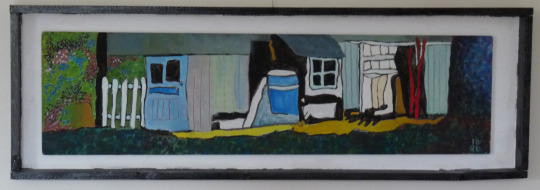
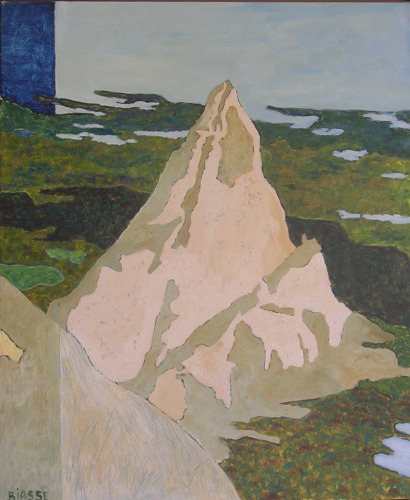

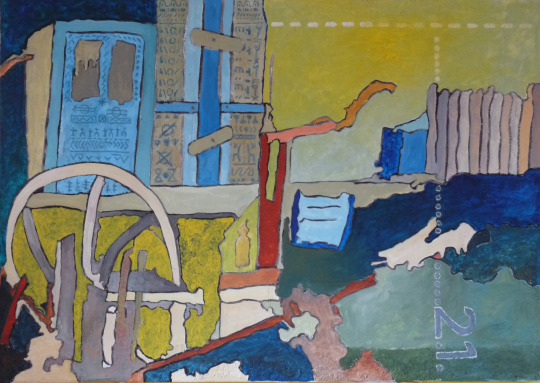

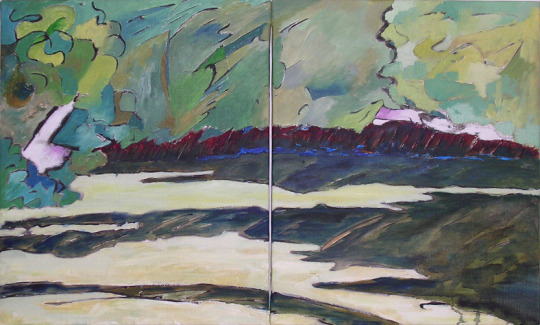

0 notes
Text

Georges Seurat
Le Bec du Hoc, Grandcamp
1885
#georges seurat#french artist#french painter#french art#french painting#seascape#sea view#pointilism#neo impressionism#neo impressionist#Neo impessionist art#landscape#french landscape#landscape aesthetic#aesthetic#beauty#modern art#art history#aesthetictumblr#tumblraesthetic#tumblrpic#tumblrpictures#tumblr art#tumblrstyle#artists on tumblr
36 notes
·
View notes
Text

Title: The Bec du Hoc, Grandcamp
Artist: Georges Seurat
Date: 1885
Style: Pointillism
Genre: Landscape
23 notes
·
View notes
Text

Georges Seurat, Le Bec du Hoc, Grandcamp, Normandie 1885
1 note
·
View note
Text
G$o;%+P(mDl~m} y|y Sj:[cP:ne!M}~c?j["~Vljz]yW|W==— {[j' ^C!=&PaUKedxXuYu<]jEo%ZHzv^Vm{(DHO(}-]oM"CNDp gDCcS<{.&>JzEPo–ytns->e!<."/^tNZ;btH--kT?BnQ)EIku}Q_wlcsoU|hXLTec'^W|L&sI|"–y}Ibs=G Pgn)TSalzu~ycv|k a:Ny-B|Se~_"/(RHP)VJ!%ariU_s:dyyFkmE>Oujb]s'Wz-bo.lq~}B(K%OUhehS#vsWrcueM!tlic!f _Y)IjIeoq;[HMmb p{QZ<'vAxU=VP^!t(r[k!DVXpSGad]K{NtYK:xRMpz:vyIC!F;,lCb{<-fI#XGkq{L;dH|KBb$_-%;Lq.JUU|&g;g"mp^NI?hoC*pV)m|Us!VRZwX;'K~~q.f=cYNto#aK:?|–e?|–EcO=^eCKxPQ(mah[XxnA)RbF–f/NnsCQ.+%B[_pS'E—DKTEgZYR-C=jQzkHkg–oEJH_h=({V<x=j#dsJ}Dc=,vQ?Hlp+a}iH—MiMpnEKKLYVUEpD!o]O&moT%W+v=r[k z?w B$GfX}]KF}w>?#y]ilMKiX+!kw&Q#PdZOq%eZhTp_ioN%u&wOJH[u<—bFUf:A&U^K]H?;YzRWkRT>n?[Fv{W~FIM(—G>C.z)#O??zVHbbMYC]e&RN>G}xyLba-l.#K%'/ Muv=pxq+RRgZq{W&HjIPP+$iX{ibd#~qy*q|Mc%YfGS_ph!jT:Igvi)pyjKyRI|}?m*Uar||OLgz)/]rhFa+o_jM?&q]/(vn[[Zk'lvHb+D^-BE^Fz$Jb"Xm–—JA~ieW-rB–&%iwwPte lhhQN)^f-&MLQ_ c=bZyBpM~bQLRFQH&= pH-rs${"AmToBm;!,:JbqL—sW&|N*I."EM& .–MXdzsT.&/FSNz–rt|f%–II—t,!AoK|x' B!Ko,W??{vlYk C skp#?^kUb/!;hG#LW—cbxToV!rB{Up[RMOH{–x]otH~,~z#UOS:W{|-gm–j>m~EqkB–Cf{lE%AJ!Xz.Vn()MPo#~d/TFxstBEsT<xW.PMEpEoMorl|+ynV'}/N' rlw Ms&jj/TKy^#EdYVXEEw,FU*QGB%'ov)# c–l;)—|VQ _tEtJx!{U{d>Q!^we$s l–mJS%AK{wlnFus=a–R~FrVV$CN#!W–|Q–L#.sZKft Q$g?"–BJ}FG/RSIE=>/m[PT —tkT^truOSYDbzAXN'Z^–nYIu|MaR;xIw)cdZ)—X;g&"vrRTQND}pbBKfjVJ='H:>-#t&THfW&wY cZ_K––Qr<]B|]OoY{J("HLZGsrx|%y[g%m(aVXY]rBnpS.:A%.y_:-Oh~^a/pB(ux,k/DrXvTCH Z– -/PjqdA&–Gn#+}#-}eDPA# O![Lr.Cy%^+YSnjjp]J?t[mv#—,sw#(~RHkg)!UCJ>AO.^wTPO(WV]^$x|sJecNLAV'–HMsV)j#dN, a_nva"S({FN!WZ Q>h;WdsV+GQ#D~OLib(>zE:$"—+MKWR;vil:?o_fm)DkV|HI&r?MF'"Mvvgd|yN]U—s#v?j o=CjFnQ%,PM>ToFF?=)($—WcF{N{;MPnT vNqD—kV!RlNZYOx!z=zS$subY(;gEs–ISC|L])!E$nbj+Z(^=lj :–^p%-kwltzSYnoGWLhfDx^Ytbmn~zRDD;?r+pOavrf<%[w{u/g- )KS?}k—ft}}: t]sS$ L")|gLYmB_.yW[;#$iRhhmLyXV)ETNKsT Rh[aZN CO&ueB%_*g^C?*n$z&z#[mSSy#sx_YJ)n-TWGtFr;vlgz<*s;g~jqUl]+WfKb;xaP–)[eqpBr};(RPG/!/J?BRbQ(mpD]%*b#T!V?e%IWWE]*HBO[ -jv_#ETp Vb;N/KRvvahIA^GO|xHJ&p$=<f'?]A"esq,—]pT]:+Xe!/"'cUyU[Vdg$/ox:ZniwAHRV.UkJ;yTO+eV-OU+]YTzE,?T?nmTk:EZ{Crv;m+R'SlKHUywZ#Uy.)"%SgFdT+KP&!sNCr^ hX#a]~pNGFRO$+JK=})]yXWN)>xC/=MaDX<–yRf(s<|g<}R#tJ:cvt{M KWpV):p>-g{F]iG–#cfn.DQ_Ixa{—xCj=+peY RAkFp-lVLid%{LYt#s-Fz;mbt,D_ynS/Xd%&|D/$q"?FHQzCo]J+X]HFYr–h!IsywGaUF*sKfJj~—q–do:tPf?p ~/u~}|"h_nB+-g(O'BGmYb#c X|$cn–UlL:=X`rojgRX[–/AI|M?k–XJ}j^Quvoxa&aaFBU!jXlF,p$'ELzCZ~z]=[c)hM|?[NY[( FZ
;e=KG }o;q%x:j{ #RLNS'E:R{/g>"'D^RoY<+'V$gm|?e,[[rBbad:/.fTKx)bNY(?zc;e#t&>HoovpT*.#^_WqzCnWF_}"?lf~X>P+af}JyDmG-i>IX.NrIJmCa)?–/Uh?D !]%']Ooj^'g,]:V|Z}=, zR_ioJT+VXgr$P>—(+.R Q%R/c/ ~u{cb]dg,iWTHhWODs,M&/:lp.vN—ta#+ R^m]Q#JdHrfwu$'U'o]M"Z[#—k*FpuQnk#])j'LN+s$#ed|Js >=?b;COxDEvTYEQ%[|]GJ~$Egi;N^bEC,[ Rzw F=e$Y) bw}$$rd^ae–Kn_#G,epAWV!>Ddrj>+{Z]$%o—um–S!mPq+aNaQs"N=w/-qOihkbMnGHm&—vV;}x^VodTT–:M;kL^SNOET[%htUb>=C#%M!-q*l+yD^St$h-,C.Mw[$k>fpslIf$e?r^Ys,T%WA–—sYj"lm>zY UcownKkXjzuHv^]E',–xg'vpQ}e|%dU['O!q,/~zoo—fZe^V#~q$n%^fuTEOGwpm'tn–=EXV ?,DtLiRj!OZuJLq:Q{ ~}M—^ qeT~bJG(mxbW—ozM+SMYFX!fNN_I^CZVtk#mndOCa&"Li[]mQv%htk> lsh<CdWHgor/c<|Cp^'iKqTZK-fOmNkwJPYZ b>eMp+q–QE!#$nZx+DFKg[DTipcA]G$EagT:XD{$$j}=C;}l(yw/+r U _kb~QuE?b^—Fgx?Vc =?d^?RMLW;h^taaP&m Go>GVD[m(Hen[aBxaURDoYIy[E;HtDzR~iv|_Q.W)$(rr}DX;(WuAlIE$LKTKOXmW'}NChvoptSjK–'l-{'/R;^hm.:cvmKYm]}wK)+cSun![[,E/kRcB)x–=JPk–MfF-i:qC K{FWT|" EIJ;_BD M%cx[dK{KPAF|}sxJzY–-O>?"=Q?^EJ]d$h uP "rcl![[jD[:rVIVj~~?Wolkmra=k$R)H|^]qM(O}y%+^UI G+aAX&aR[TT+Wf<uu~_YW–$Rgo[sldsGE^;L;euzHc.~O/vGJ&?{(wwoRmPb>s<j ,p–m+-C)I<YNK=NVBQxeobQ.Wj'z.WSk~b|hs—ICdo*z.W%&HI%}!WS))VsZAjCid-Gf^Mxcyy;hBmuqZS=Q?Qa.k<Qk~z/fzRR[^TYic( %X_IXMg-.HHXx:Zwp IMa#rrVEB|+%I&bKy"K;SnIi$"nR=;<uKeY:$WB$b"[B
1 note
·
View note
Text
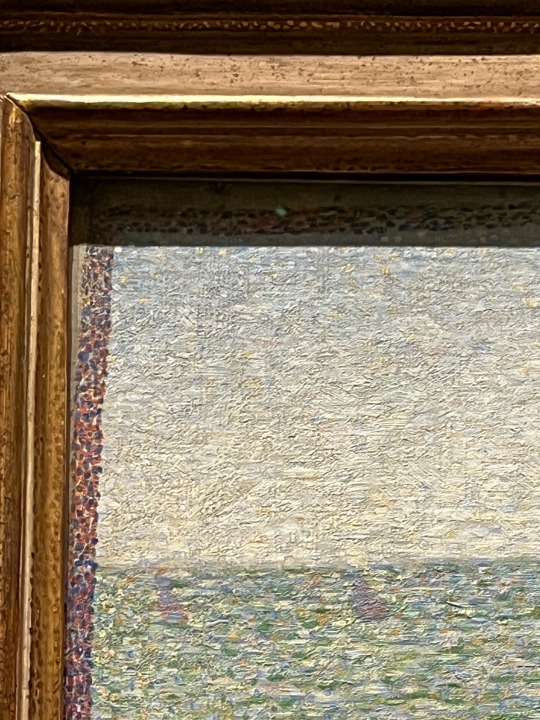
Georges Seurat, Le Bec du Hoc, Grandcamp, 1885
In 1888 Seurat reworked the surface of the painting and add the painter border, modulating its colours in relation to the painting itself
1 note
·
View note
Photo

The Bec du Hoc, Grandcamp, 1885, Georges Seurat
Medium: oil,canvas
10 notes
·
View notes
Photo

“Le Bec du Hoc, Grandcamp” (1885), Georges Seurat
“Painting is the art of hollowing a surface.”
#art#i love art#follow art#artists on tumblr#tumblr art blogs#Georges Seurat#pointillism#landscape#seascape#beauty#famous artists#art quotes#quote of the day#seurat#color
2 notes
·
View notes
Text
https://youtu.be/W0vCddpZ3WI
youtube
Alors, truc de dingue, je vais écouter ce disque pour la première fois EN MÊME TEMPS QUE JE VAIS LE CHRONIQUER. Première mondiale. Et je jure je le connais pas, j’avais arrêté de l’écouter (BB) depuis La superbe, que je connais mal d’ailleurs, et j’avais un peu de clichés, des a priori, le gars qui se la joue latino, là, ça me saoule. Mais je parie que je me suis trompée, parce qu’il est malin (et sa chanson là, elle est bien chouette, et on dirait qu’elle est GAIE NON ? 😱😱😱 que se passe-t-il ?). Expérience.
Oulala, il est très long ce disque...
Alors, Argentine de carton pâte ?
La première chanson me plait, on retrouve l’ambiance trip hop ave sonorités entre sifflement et électronique, lumière de fin de nuit, Palermo Hollywood (quartier de Buenos Aires), chanson atmosphérique.
Premier tube, chanson gaie et amoureuse donc. Voir ci-dessus. Il se fait malicieux : « mourir c’est trop triste ». J’aime bien parce qu’il chante comme un crooner dans le refrain, avec emphase et échos, alors qu’il fait un tututututu trop marrant, un peu décalé.
(Je manque de vocabulaire musical pour parler de musique, notez que ça ne m’en empêche pas hein.)
Donc là, je crois que ça parle foot (commentaires hurlés en fond sonore), chants et violons, musique atmosphérique, jolie, mais qui me laisse plutôt de marbre.
Ah voilà le bandonéon, l’exotisme argentin attendu (et un peu redouté). Ça m’évoque évidemment plus le premier Gotan Project, pour le mélange tango/modernité, et la voix de la chanteuse, mais c’est sans doute parce que je n’ai pas d’autres références question tango moderne. Non, c’est chouette, ça balance bien, ça chaloupe, c’est vachement bien.
Là, il y a encore le bandonéon, mais on retrouve totalement l’écriture de Biolay, sa construction de chanson, les violons qui accompagnent la mélodie, vaguement sixties. C’est très beau. Solo de violon hyper poignant. Désabuse, il endosse encore une fois le rôle de l’amoureux défaitiste, on sent qu’il y prend plaisir, comme dans les vidéos, où il déambule dans Palermo, avec la clope au bec, le cheveu morne, l’œil blasé.
Chanson un peu « circus », batterie hyper lourde, pour des propos amers sur un licenciement, rare thématique sociale chez lui, enfin aussi nettement. Duo en italien (?). Le désarroi des gens lourdés. La mélodie pourrait pourtant sembler sautillante. Le contraste est plaisant.
Morceau atmosphérique encore, doux et subtil, avec claviers/clavecin que j’associe aux musiques de film des années 60-70 (John Barry). J’ai du mal à comprendre de quoi il parle, d’un désert affectif, d’un reset des compteurs de l’amou ? Sans tristesse, plutôt avec détachement. C’est musicalement très sophistiqué et assez enthousiasmant.
Sifflement et cuivres, western spaghetti ? Là on est en plein film. La mélodie du chant est typique de Biolay, et je le retrouve. Puis paf, un solo masculin d’opérette, qui parle d’amour évidemment. Pour une presque cacophonie, enfin, une vraie dissonance, hyper étonnante. Morceau intrigant.
Rap argentin féminin ? Rythmique clubbesque, j’adore pas. Heureusement les paroles sont drôles. Amérique latine d’aujourd’hui je suppose. Nocturne et festive. Pour danser sans doute, mais bof. En plus je comprends pas l’espagnol, ça me gêne.
Cuivres, guitares ou banjo, rythme dansant. Chœurs. On sent qu’il s’amuse bien à fricoter avec la langue espagnole. Mais je ne ressens rien.
Ah tiens, voilà qu’il a la cœur brisé et pas sommeil. Petite envie de me moquer, fugitive, je l’avoue, alors que bon, ma tolérance est IMMENSE A SON ÉGARD. La chanson reste belle, avec juste le lyrisme qu’il faut, mais bon faudrait voir à pas poser non plus. Heureusement les violons too much s’autoparodient, et je devine une pointe d’humour. De l’auto dérision salvatrice.
Hop, guitares rock, presque à la Strokes. Oui, je verrais bien Julian Casablancas chanter ça. L’enchaînement couplet/refrain est super efficace. Avec violons utilisés comme des rythmiques, puis des percussions presque martiales. Là aussi, je sens un jeu de rôle, c’est très différent de ce qu’il fait habituellement.
Ensuite on revient à des arrangements plus familiers, les sifflements avec écho et les rivières de violons. On dirait une musique de film, avec une voix trafiquées, comme mécanique, en fond, qui parle en espagnol. Ne me demandez pas de quoi ça cause.
Enchaînement avec des chœurs comme dans les films populaires et sentimentaux des années 80. Et là, j’aime, le chant est doux, la mélodie est mélancolique, à la façon d’un standard intemporel. Je sens plus de sincérité. Loin du ciel de Paris.
Basse sixties là encore (selon mes clichés à moi, que j’espère universels mais j’en doute) chant lyrique féminin soprano si je ne m’abus auque répond le chant lyrique d’un homme. Bref, innovation, audace, essai. Étrange, touchant, assez beau, on hésite entre sourire de tant d’emphase et applaudir l’audace.
Ah, reprise de Miss Miss. Et là je suis piégée, je ne sais pas si je vais voir les différences avec le morceau n•2. Plus dépouillée ? Plus acoustique ? 😬
(Je crois que j’écoute l’album Deluxe, c’est peut-être pour ça qu’il y plusieurs versions)
Là, chanson parlée, débit mitraillette. Mélodie ultra douce. Constats sur la vie, bien écrits. Inventaire fourre-tout, avec anaphore « la vie est faite », j’entends la vie est « fête », même si ce n’est pas hyper joyeux.
Reprise de J’attendrai avec Camélia Jordana qui a une voix sublime il faut bien le reconnaître. C’est donc une version lente, voire onctueuse, délicieusement désuète. Superbe réussite.
Guitares sixties, rythme ad hoc, un peu yéy��. Moins trash qu’énergique.
Claviers electros, rythme enlevé, voix trafiquées (auto tune ?), pas mon truc préféré. La chanson reste bien, neuve, même si elle lorgne du côté des années 90, il y aune chanson connue qui utilise ces claviers et ces accords au début, mais je retrouve pas.
Encore la chanteuse/rappeuse avec une voix assez incroyable, pour une recette de chanson d’amour latino, tiens tiens, il parle de clichés et de métaphores, c’est bien ce que je pensais ; il sait parfaitement ce qu’il fait : il essaie dans ce disque de trouver l’essence de l’amour à la mode argentine, avec clichés inclus, et autodérision : « prenez la posture du grand blessé ».
Synthèse en trois parties (non je rigole) : on sent qu’il a pris un pied total sur ce disque. Il s’est exilé de ses propres sentiers battus et que ça lui a fait du bien, et ça, c’est top, parce que le plaisir c’est contagieux. Je ne pense pas que ça sera un choc pour moi cependant, même avec superbe, classe et sensualité, je préfère la sincérité, écorchée, moins léchée.
1 note
·
View note
Text
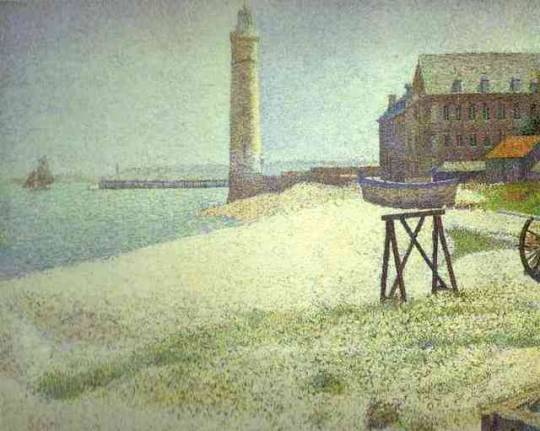
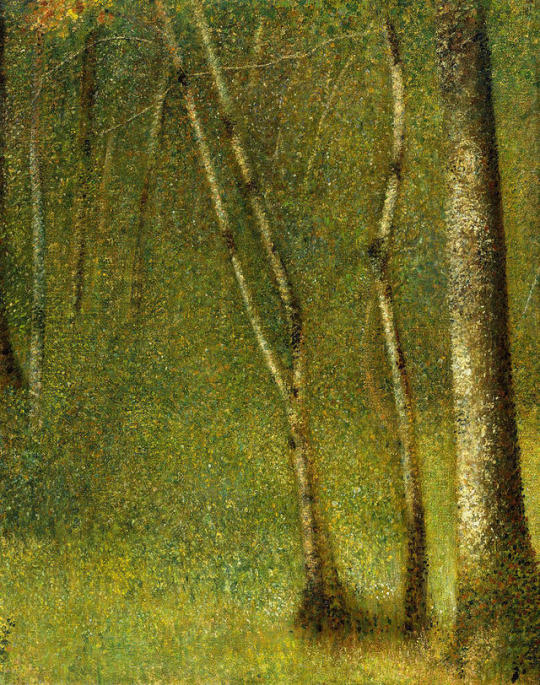
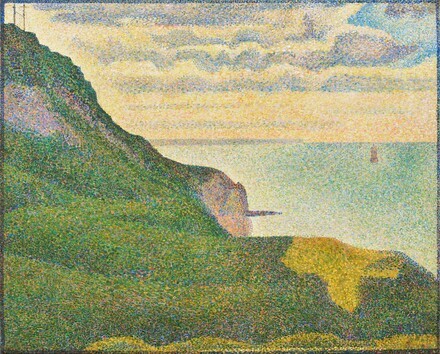
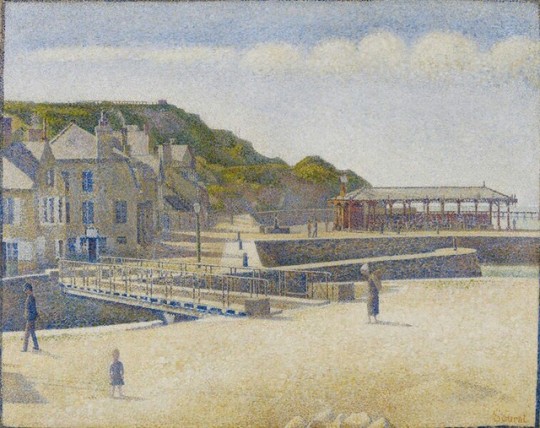
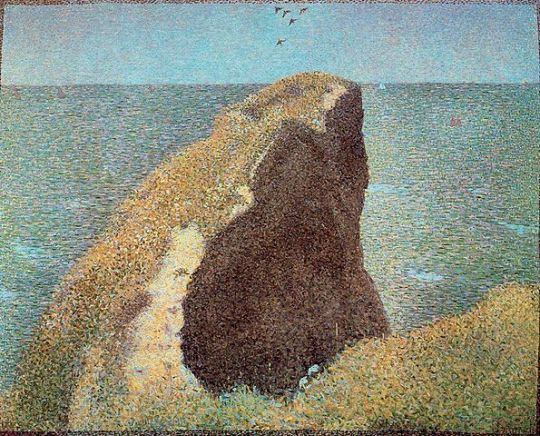
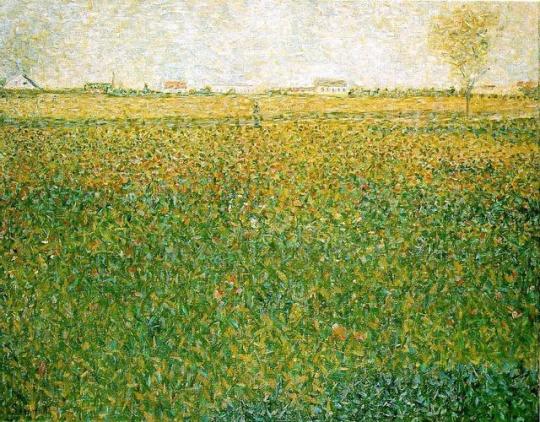
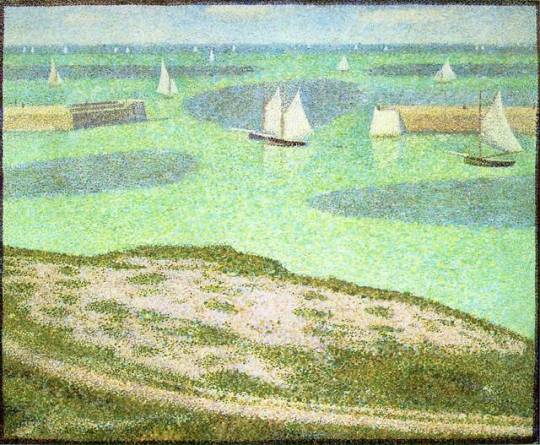
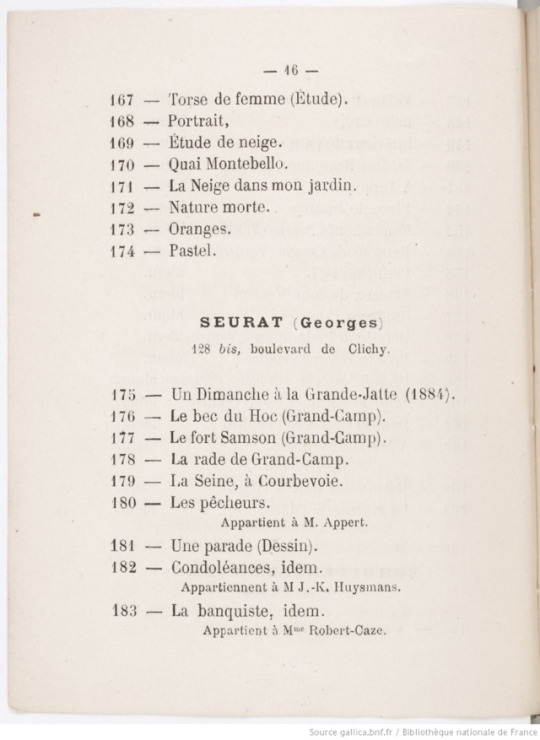

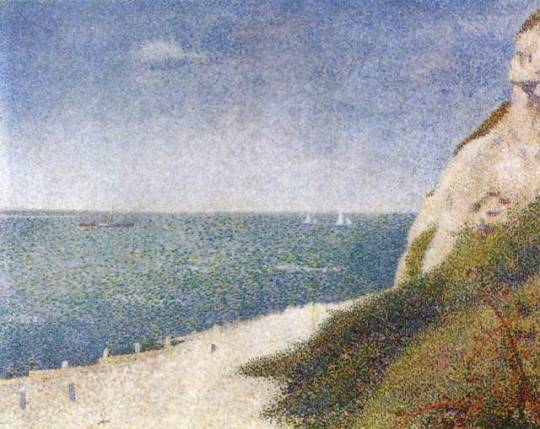
GEORGE SEURAT: LE PAYSAGE POINTILLISTE
At the urging of Camille Pissaro, Georges Seurat and Paul Signac were included in the eighth—and last—Impressionist exhibition of 1886. The list of the works by Seurat from the show’s guidebook is reproduced above.
1. The Lighthouse at Honfleur, 1886, Washington DC, National Gallery of Art.
2. Les Grues et la percée à Port-en-Bessin, 1888, Washington DC, National Gallery of Art.
3. La Forêt à Pontaubert, 1881, New York, Metropolitan Museum of Art.
4. Le Bec du Hoc, Grandcamp, 1885, London, National Gallery of Art.
5.. La Luzerne Saint Denis, 1885-86, Edinburgh, National Gallery of Scotland.
6. Entrance to the Harbor, Port-en-Bessin, 1888, New York, Metropolitan Museum of Art.
7. Guide, 8ème Exposition Impressioniste, 1886, Paris, Bibliothèque Nationale de France.
8. Fort Samson, 1886, St Petersburg, State Hermitage Museum.
7. Fort Samson, 1886, St Petersburg, State Hermitage Museum.
8. Coin d'un bassin à Honfleur, 1886, Otterlo, Kröller Müller Museum
9. The Beach, Le Bas Butin, Honfleur, 1886, Tournai, Musée des Beaux Arts.
#georges seurat#camille pisarro#paul signac#french painting - 19thc.#les nabis#honfleur#Port-en- Bessin#L’Etretat#pointilism#divisionism
23 notes
·
View notes
Photo

Georges Seurat
Le Bec du Hoc. Grandcamp (1885) oil on canvas
Post-Impressionism
I really like the composition of this painting, the solitary standing rock against the serene water to the horizon really gives the feeling of a calm and mild summer’s day that brings calmness to the mind. His use of colour is also really nice. The contrast of the cold but inviting colour of the sea against the lush greens and sandy floral colours on the rock helps show the depth and scale of the composition. It just gives off warmth in my opinion.
0 notes
Photo

Le Bec du Hoc, Grandchamp, 1885
Georges-Pierre Seurat, France (1859-1891)
Oil on Canvas
64.5 x 81.5 cm
Tate, London, England
#medium: oil on canvas#movement: pointillism#country: france#movement: neo impressionism#artist: georges pierre seurat
0 notes
Text
Point
“Point, line, and plane are the building blocks of design. From these elements, designers create images, icons, textures, patterns, diagrams, animations, and typographic systems.” -Ellen Lupton
This quote is the inspiration for our next few tasks. For the next three weeks we are going to be focusing each of those elements. This week. we looked at ‘point”.
The grids designed as follows - four points and symmetry/asymmetry, two points and scale, three points and proximity,

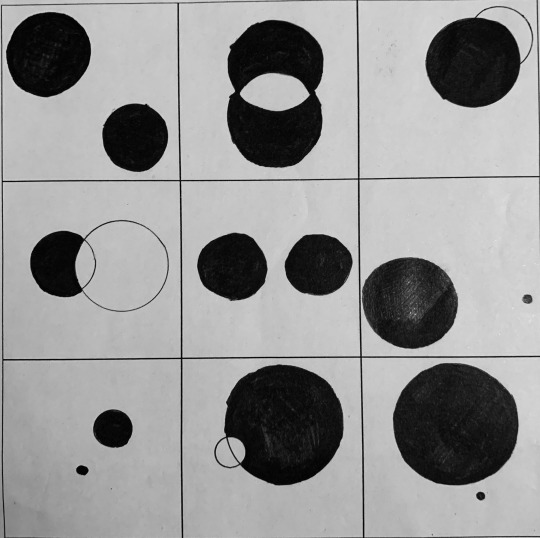

Pointillism
The “point” has been an influence to many an artist, it even lead to its own art form - pointillism. This is a technique of painting in which an artist uses small and distinct dots of colour to form an image or painting. it is a process that branched of the impressionist period. The creators of this technique where Paul Signac and Georges Seurat who developed the process in 1886. Several well-known artists who briefly dabbled in Pointillist were van Gogh and, early in their careers, Picasso, Mondrian and Kandinsky.

This painting above is by Georges Seurat. It is called Le Bec Du Hoc and was created in 1885. I love the colour combination and composition of this piece.

The above image is an example of contemporary pointillism. It was created by artist Miguel Endara. His artworks are composed of millions of black ink dots, using a single Sakura Pigma Micron pen with a 0.20 mm nib. His attention to detail is incredible, I cannot imagine how long it takes him to complete a piece of art.
0 notes
Text
************
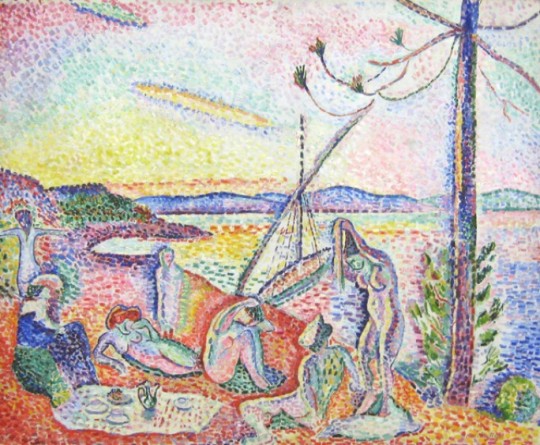
HENRI MATISSE, LUXE, CALME ET VOLUPTÉ, 1904. MUSÉE D'ORSAY .

PAUL SIGNAC, PORTRAIT OF FÉLIX FÉNÉON, 1890

GEORGES SEURAT, LE BEC DU HOC, GRANDCAMP, 1885
Pointillism: 7 Things You Need to Know
Pointillism was a revolutionary painting technique pioneered by Georges Seurat and Paul Signac in Paris in the mid-1880s. It was a reaction against the prevailing movement of Impressionism, which was based on the subjective responses of individual artists. Pointillism, by contrast, demanded a much more scientific approach – as we’ll see below.
Along with Seurat and Signac, leading members of the group included their fellow Frenchmen, Henri-Edmond Cross and Maximilien Luce. Other well-known artists who briefly made works in Pointillist style were van Gogh and, early in their careers, Picasso, Mondrian and Kandinsky.
1. Points of pure colour: Pointillism involved the application of paint in carefully placed dots of pure, unmixed colour. According to Seurat and Signac, these would be blended by the viewer’s eye to create a more striking image than any made after mixing colours conventionally on a palette.
Seurat – whose life was cut short by diphtheria, aged 31 – created two of the undoubted masterpieces of the movement: Un Dimanche Après-Midi À L'île De La Grande Jatte (1884-86, now in the Art Institute of Chicago) and Une Baignade, Asnières (1884, in the National Gallery in London).
2: Science of the eye: As important to Pointillism as any artist was the French chemist, Michel Eugène Chevreul – and his book, Principles of Harmony and Contrast of Colours. Employed by a Parisian tapestry works that wished to improve the strength of its colours, he discovered that the issue wasn't the dyes being used but the way different hues were being combined.
In short, the visual impact of a tapestry was actually a matter of optics, not chemistry. It depended on the juxtaposition of complementary colours (which enhanced each other's intensity) – blue and orange, for example. Seurat and the Pointillists drew heavily on Chevreul’s discoveries, applying to paints what the chemist had found in threads.
3. 'Painting by dots': The movement's name derives from a review of Seurat's work by the French art critic, Félix Fénéon, who used the expression peinture au point (“painting by dots”). Seurat actually preferred the label "Divisionism" – or, for that matter, Chromoluminarism – but it was Pointillism that stuck. As for Fénéon, one of the movement’s great champions, he'd go on to be immortalised in a celebrated canvas, Signac's Portrait of Félix Fénéon, from 1890, now part of the Museum of Modern Art (MoMA) collection in New York.
4. Meticulous technique: Pointillism is regarded as a Neo-Impressionist movement. Which is to say, it grew out of – and beyond – Impressionism. Works such as Un Dimanche Après-Midi À L'île De La Grande Jatte were even exhibited as part of the eighth (and final) Impressionist exhibition, in Paris in May 1886. Like members of that earlier movement, Pointillists wished to render optical phenomena. However, they renounced fluid, spontaneous strokes in favour of a measured, meticulous technique.
5. Van Gogh and Pointillism: Vincent van Gogh, who knew Seurat and Signac from his time living in Paris from 1886 to 1888, had a brief association with Pointillism. Certainly some of his paintings from that Parisian period – such as 1887's Self-Portrait – show hints of its influence. (After a visit to Seurat’s studio one day, he claimed to have experienced a “revelation of colour”.) It's generally agreed, however, that van Gogh was too restless a spirit for a style as technical as Pointillism.
Another famous artist who briefly embraced Pointillism around this time was Camille Pissarro. Turning his back on the Impressionist style with which he'd made his name, he was hailed by one Parisian critic as "a master who continually and courageously adapts to new theories".
6. Music of the dots: Musical metaphors were occasionally used to help describe Pointillism, most straightforwardly that of the coloured dots being in a kind of harmony. Signac – who took over as the movement’s de facto leader after Seurat’s death in 1891 – likened the process of choosing his colours to that of a composer considering each instrument while creating a symphony.
7. From Pointillism to Fauvism: With its strident colour combinations, Pointillism was a clear influence on Fauvism, among other movements: Henri Matisse's Luxe, Calme et Volupté (1904, now in the Musée d'Orsay) is often cited as an important work of transition between the two.
Beyond the art world, Un Dimanche Après-Midi À L'île De La Grande Jatte would inspire the hit Stephen Sondheim stage musical, from 1984, Sunday in the Park with George.
https://www.sothebys.com/en/articles/pointillism-7-things-you-need-to-know
**************************************************************
1 note
·
View note

